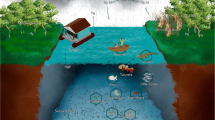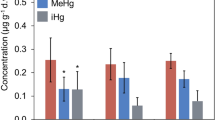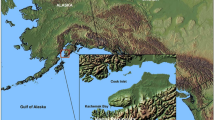Abstract
Striped bass (Morone saxatilis), white perch (Morone Americana), and largemouth bass (Micropterus salmoides) were collected in the Chesapeake Bay mainstem and tributaries and analyzed for total mercury (Hg) and methylmercury (MeHg) content. Striped bass are anadromous, whereas white perch and largemouth bass are resident species, and the largemouth bass are also restricted to the tidal fresh portion of the Bay. Total Hg and MeHg concentrations in striped bass increased with fish size, and large fish (>7.5 kg wet weight) tended to have MeHg concentrations of 300 ng g−1 or greater. On average, the striped bass MeHg concentration was 120 ± 100 ng g−1 and the fraction of the total Hg as MeHg was 65 ± 22%. Reasons for the lower relative MeHg content are discussed. Otolith strontium/calcium ratios were also determined to examine whether migration had a significant impact on MeHg content in striped bass. Resident fish did appear to have a higher MeHg burden than the more migratory fish of similar size. Largemouth bass and white perch tended to have low MeHg content (respectively, 14 ± 7 and 13 ± 11 ng g−1; all fish <1 kg wet weight), and the white perch also had a low %MeHg (28 ± 14%), reflecting their mostly planktivorous lifestyle. A comparison of largemouth bass and striped bass MeHg concentrations for the estuarine fish with those of fish in Maryland reservoirs of similar size showed that the estuarine fish have much lower MeHg burdens. Differences in MeHg concentration in the estuarine waters compared to the reservoir waters likely account for much of this difference, although the importance of other factors is also discussed.






Similar content being viewed by others
References
Baeyens W, Leermarkers M (1996) Particulate, dissolved and methylmercury budgets for the Scheldt estuary (Belgium and the Netherlands). In: Baeyens W, et al. (eds) Global and regional mercury cycles: sources, fluxes, and mass balances. Kluwer Academic Publishers, Dordrecht, The Netherlands. pp 285
Baeyens W, Leermakers M, Papina T, Saprykin A, Brion N, Noyen J, De Gieter M, Elskens M, Goeyens L (2003) Bioconcentration and biomagnification of mercury and methylmercury in North Sea and Scheldt estuary fish. Arch Environ Contam Toxicol 45:498–508
Benoit JM, Gilmour CC, Heyes A, Mason RP, Miller CL (2003) Geochemical and biological controls over methylmercury production and degradation in aquatic ecosystems. In: Biogeochemistry of environmentally important trace elements. American Chemical Society Publ, ACS symposium series 835, pp 262–297
Benoit JM, Gilmour CC, Mason RP, Heyes A (1999) Sulfide controls on mercury speciation and bioavailability in sediment pore waters. Environ Sci Technol 33:951–957
Benoit JM, Gilmour CC, Mason RP, Riedel GS, Riedel GF (1998) Behavior of mercury in the Patuxent estuary. Biogeochem 40:249–265
Benoit JM, Mason RP, Gilmour CC (2001) Aspects of the bioavailability of mercury for methylation in pure cultures of Desulfobulbous proprionicus (1PR3). Appl Environ Microbiol 67:51–58
Blankenship K (2004) Menhaden stock perplexes fish managers. bay J 14(6). http://www.bayjournal.com/04-09/menhaden.htm
Bloom NS (1989) Determination of picogram levels of methylmercury by aqueous phase ethylation, followed by cryogenic gas chromatography with cold vapor atomic fluorescence detection. Can J Fish Aqua Sci 46:1131–1140
Bloom NS (1992) On the chemical form of mercury in edible fish and marine invertebrate tissue. Can J Fish Aqua Sci 49:1010–1017
Bloom NS, Fitzgerald WF (1988) Determination of volatile species at the picogram level by low temperature gas chromatography with cold vapor atomic fluorescence detection. Analytical Chim Acta 208:151–161
Cunningham P, Cooter W, Sullivan E (2003) Mercury in marine life database. Prepared by RTI International for USEPA, April 2003
Driscoll CT, Blette V, Yan C, Schofield CL, Munson R, Holsapple J (1995) The role of dissolved organic carbon in the chemistry and bio availability of mercury in remote Adirondack lakes. Water Air Soil Poll 80:499–508
Fitzgerald WF, Clarkson T (1991) Mercury and monomethylmercury—present and future concerns. Environ Health Perspect 96:159–166
Gilmour CC (1999) A preliminary survey of size-specific mercury concentrations in game fish from Maryland fresh and estuarine waters. Chesapeake bay and watershed programs: monitoring and non-tidal assessment CBWP-MANTA-AD-98-9
Gilmour CC, Henry EA, Mitchell R (1992) Sulfate stimulation of mercury methylation in freshwater sediments. Environ Sci Technol 26:2281–2287
Gilmour CC, Riedel GS (2000) A survey of size-specific mercury concentrations in game fish from Maryland fresh and estuarine waters. Arch Environ Contam Toxicol 39:53–59
Greenfield BK, Davis JA, Fairey R, Roberts C, Crane DB, Ichikawa G, Petreas M (2003) Contaminant concentrations in fish from San Francisco Bay, 2000. SFEI Contribution # 77, San Francisco Estuary Institute, July 2003
Griffin JC, Margraf FJ (2003) The diet of Chesapeake bay striped bass in the late 1950s. Fish Manage Ecol 10:323–328
Heyes A, Mason RP, Kim E-H, Sunderland E (2005) Mercury methylation in estuaries. Mar Chem (in press)
Heyes A, Miller C, Mason RP (2004) Mercury and methylmercury in Hudson River Sediment: Impact of resuspension on portioning and methylation. Mar Chem 90:75–89
Hildebrand SF, Schroeder WC (1928) Fishes of Chesapeake Bay. Bulletin of the Bureau of Fisheries, pp 242–251
Holsbeek L, Das HK, Joiris CR (1997) Mercury speciation and accumulation in Bangladesh freshwater and anadromous fish. Sci Tot Environ 198:201–210
Hudson RJM, Gherini SA, Watras CJ, Porcella DP (1994) Modeling the biogeochemical cycle of mercury in lakes: The mercury cycling model (MCM) and its application to the MTL study lakes. In: Watras CJ, Huckabee JW (eds), Mercury pollution: integration and synthesis. Lewis Publishers, Boca Raton, Florida, pp 473–526
Hudson River Foundation (HRF) (2004) Health of the harbor: The first comprehensive look at the state of the NY/NJ harbor estuary. http://www.harborestuary.org/reports/harborhealth.pdf
Kannan K, Smith RG, Lee RF, Windom HL, Heitmuller PT, Macauley JM, Summers JK (1998) Distribution of total mercury and methyl mercury in water, sediment, and fish from south Florida estuaries. Arch Environ Contam Toxicol 34:109–118
Kim EY, Saeki K, Tanabe S, et al. (1996) Specific accumulation of mercury and selenium in seabirds. Environ Poll 94:261–265
Kraus RT, Secor DH (2004) Incorporation of strontium into otoliths of an estuarine fish. J Exper Mar Biol Ecol 302:85–106
Lawrence AL, Mason RP (2001) Factors controlling the bioaccumulation of mercury and methylmercury by the estuarine amphipod Leptocheirus plumulosus. Environ Poll 111:217–231
Lawrence AL, McAloon KM, Mason RP, Mayer LM (1999) Intestinal solubilization of particle-associated organic and inorganic mercury as a measure of bioavailability to benthic invertebrates. Environ Sci Technol 33:1871–1876
Mansueti RJ (1961) Age, growth, and movements of the striped bass, Roccus saxatilis, taken in size selective fishing gear in Maryland. Ches Sci 2:9–36
Mason RP (2002) The bioaccumulation of mercury, methylmercury and other toxic elements into pelagic and benthic organisms. In: Newman MC, Robert MH, Hale RC (eds) Coastal and estuarine risk assessment. CRC/Lewis Publishers, pp 127–149
Mason RP, Benoit JM (2003) Organomercury compounds in the environment. In: Craig P (ed), Organometallics in the environment. John Wiley & Sons, New York, pp 57–99
Mason RP, Fitzgerald WF (1996) Sources, sinks and biogeochemical cycling of mercury in the ocean. In: Baeyens W, Ebinghaus R, Vasiliev O (eds), Global and regional cycles of mercury: sources, fluxes and mass balances. Kluwer Academic Publishers, Dordrecht, the Netherlands, pp 85–108
Mason RP, Fitzgerald WF, Morel FM (1994) The biogeochemical cycling of elemental mercury: anthropogenic influences. Geochim Cosmochim Acta 58:3191–3198
Mason RP, Lawrence AL (1999) Concentration, distribution, and bioavailability of mercury and methylmercury in sediments of Baltimore Harbor and Chesapeake Bay, Maryland, USA. Environ Toxic Chem 18:2438–2447
Mason RP, Lawson NM, Lawrence AL, Lee JG, Leaner JJ, Sheu G-R (1999) Mercury in the Chesapeake Bay. Mar Chem 65:77–96
Mason RP, Lawson NM, Sheu G-R (2000) Annual and seasonal trends in mercury deposition in Maryland. Atmos Environ 34:1691–1701
Mason RP, Lawson NM, Sullivan KA (1997) Atmospheric deposition to the Chesapeake bay watershed: regional and local sources. Atmos Environ 31:3531–3540
Mason RP, Reinfelder JR, Morel FM (1996) Uptake, toxicity and trophic transfer of mercury in a coastal diatom. Environ Sci Technol 30:1835–1845
Mason RP, Sheu G-R (2002) The role of the ocean in the global mercury cycle. Global Biogeochemical Cycles, 16(4), 1093, doi:10.1029/2001GBC001440
Mason RP, Sveinsdottir AY (2003) Mercury and methylmercury concentrations in water and largemouth bass in Maryland reservoirs. Final report submitted to Maryland Department of Natural Resources, CBWP-MAN7A-AD-03-1. Also a paper on this topic is currently in review for Arch Environ Contam Toxicol
MDE (2004) Maryland Department of the Environment Mercury Website. http://www.mde.state.md.us/Programs/LandPrograms/Hazardous-Waste/Mercury
Morel FMM, Kraepiel AML, Amyot M (1998) The chemical cycle and bioaccumulation of mercury. Ann Review Ecol Systematics 29:543–566
Murdy EO, Birdsong RS, Musick JA (1997) Fishes of the Chesapeake Bay. Smithsonian Institution Press, Washington and London, pp 216–244
National Oceanographic and Atmospheric Administration (NOAA) (2003) Commercial and recreational fish of the Chesapeake Bay. http://www.noaa.chesapeakebay.net/species.htm
Riget F, Asmund G, Aastrup P (2000) Mercury in Arctic char (Salvelinus alpinus) populations from Greenland. Science Total Environ 245:161–172
Rochelle-Newall EJ, Fisher TR (2002) Chromophoric dissolved organic matter and dissolved organic carbon in Chesapeake Bay. Mar Chem 77:23–41
Rodgers DW (1994) You are what you eat and a little bit more: bioenergetics-based models of methylmercury accumulation in fish revisited. In: Watras CJ, Huckabel JW (eds) Mercury pollution: integration and synthesis. Lewis Publishers, New York, pp 427–439
Rolfhus KR, Fitzgerald WF (1995) Linkages between atmospheric mercury deposition and the methylmercury content of marine fish. Water Air Soil Poll 80:291–297
Rudd JWM (1995) Sources of methylmercury to freshwater ecosystems: A review. Water Air Soil Poll 80:697–713
Secor DH, Rooker JR, Zlokovitz E, Zdanowicz VS (2001) Identification of riverine, estuarine, and coastal contingents of Hudson River striped bass based upon otolith elemental fingerprints. Mar Ecol Prog Ser 211:245–253
Sheu G-R, Mason RP, Lawson NM (2002) Speciation and distribution of atmospheric mercury over the Northern Chesapeake Bay. In: Lipnick RL, Mason RP, Phillips ML, Pittman CU Jr (eds) Chemicals in the environment: fate, impacts, and remediation. American Chemical Society Publishers, ACS symposium series no. 806, pp 223–242
Sveinsdottir AY (2002) Methylmercury in largemouth bass (Micropterus salmoides) and forage fish from Maryland reservoirs and factors influencing uptake. Masters Thesis. University of Maryland, Chesapeake Biological Laboratory
Sveinsdottir AY, Mason RP (2005) Factors controlling mercury and methylmercury concentrations in largemouth bass (Micropterus salmoides) and other fish from Maryland reservoirs. Arch Environ Contam Toxicol 49:528–545
US Environmental Protection Agency (USEPA) (1995) National listing of fish consumption advisories. USEPA, EPA-823-F-95-004, Office of Water, Washington, DC
USEPA (2004) Fish consumption advice webpage. http://www.epa. gov/waterscience/fishadvice/advice.html
US Federal Drug Administration (USFDA) (2002) Consumer advisory: an important message for pregnant women and women of childbearing age who may become pregnant about the risks of mercury in fish. http://www.vm.cfsan.fda.gov/∼dms/admehg.html
U.S. Geological Service (USGS) Website (2004) http://www.md.water.usgs.gov/
Wagemann R, Trebacz E, Boila G, et al. (1998) Methylmercury and total mercury in tissues of arctic marine mammals. Sci Tot Environ 218:19–31
Walter JF, Austin HM (2003) Diet composition of large striped bass (Morone saxatilis) in Chesapeake Bay. Fish Bull 101:414–423
Watras CJ, Bloom NS (1992) Mercury and methylmercury in individual zooplankton. Liminol Oceanog 37:1313–1318
Watras CJ, Bloom NS, Hudson RJM, Gherini S, Munson R, Claas SA, Morrison KA, Hurley J, Wiener JG, Fitzgerald WF, Mason RP, Vandal G, Powell D, Rada R, Rislov L, Winfrey M, Elder J, Krabbenhoft D, Andren AW, Babiarz C, Porcella DB, Huckabee JW (1994) Sources and fates of mercury and methylmercury in Wisconsin lakes. In: Watras CJ, Huckabee JW (eds) Mercury pollution: integration and synthesis. Lewis Publishers, Boca Raton, Florida, pp 153–177
Weiss J, Trip L, Mahaffey KR (1999) Methylmercury: a new look at the risks. Public Health Reports 114:397–401
Wiener JG, Krabbenhoft DP, Heinz GH, Scheuhammer AM (2002) Ecotoxicology of mercury. In: Hoffman DJ, Rattner BA, Burton GA Jr, Cairns J Jr (eds), Handbook of ecotoxicology, 2nd ed. CRC Press, Boca Raton, Florida, pp 409
Wolfe MF, Schwarzbach S, Sulaiman RA (1998) The effects of mercury on wildlife: a comprehensive review. Environ Toxicol Chem 17:146
World Health Organization (1990) Environmental health criteria 101: Mercury I. Geneva, pp 144
Acknowledgments
This research was funded by grant MA01-001-002 from the MD DNR through the Power Plant Research Program. We would like to thank Paul Miller, and personnel at the MD DNR, for their help in the collection of fish samples. Samples were also collected by Maryland Department of the Environment as part of their routine monitoring survey. In addition, the help of Tom Gilmour, Fritz Riedel, and their fishing colleagues in the collection of striped bass samples in 2003 and 2004 is greatly acknowledged. The analysis of samples was performed by Auja Sveinsdottir and Debby Heyes, who also coordinated the collection and processing of samples. The help of Heather Soulen is also appreciated. We would also like to thank all members of the Mason laboratory for their help with water and fish analyses as well as with fieldwork. We thank Brenda Yates for help in manuscript preparation. This is Contribution No. XXXX of the University of Maryland Center for Environmental Science.
Author information
Authors and Affiliations
Corresponding author
Rights and permissions
About this article
Cite this article
Mason, R.P., Heyes, D. & Sveinsdottir, A. Methylmercury Concentrations in Fish from Tidal Waters of The Chesapeake Bay. Arch Environ Contam Toxicol 51, 425–437 (2006). https://doi.org/10.1007/s00244-004-0230-x
Received:
Accepted:
Published:
Issue Date:
DOI: https://doi.org/10.1007/s00244-004-0230-x




